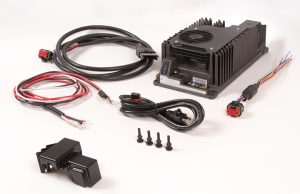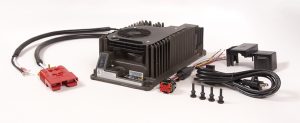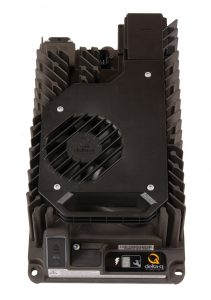
Making the switch to lithium-ion: Is it right for your product?
By Chris Botting, manager of research, Delta-Q Technologies
Electronics Power Supply / Management Engineering Supply Chain lithium-ion lithium-ionIf the Olympic athlete’s motto is ‘faster, higher, stronger,’ then the product designer’s motto might be ‘smaller, lighter, cheaper.’ When designing power equipment, machines and vehicles, the power source is often the bottleneck for size, weight, and cost, as well as for run time and reliability. In particular, fossil-fueled engines provide high-power density and quick refueling, but its maintenance, noise, and environmental impacts have increasingly become unacceptable to modern users. Electric motors solve many of these issues, though historically have inconvenient extension cords or are weighed down by large lead acid batteries. The ideal solution would be cordless, zero emission, light, powerful, and able refuel rapidly. Look no further than the cellphone in your pocket, I present the lithium-ion battery.
Over the past three decades, lithium-ion batteries have conquered cameras, laptops, and power tools. As lithium-ion prices continue to drop, the solution is poised to take over other markets including electric drive vehicles, lawn mowers, golf carts, and forklifts. Many original equipment manufacturers (OEMs) and distributors are looking to lithium-ion batteries as a significant and disruptive alternative to traditional lead acid batteries. Lithium-ion can play a dramatic role in improving run times, reducing maintenance and operating costs, as well as providing a lighter weight, higher power, faster charge times, zero maintenance and longer life solution. However, the solution is not right for every application and can present unique challenges such as cost, complexity, and safety.
As OEMs and distributors investigate the move towards lithium batteries, a more thorough understanding of lithium-ion batteries and their integration with battery management systems (BMS), and charging solutions, will help them determine if it is the right solution for their industrial applications.
Lead acid vs. Lithium-ion
The lead acid battery was invented over 150 years ago, and the basic technology and construction has not changed significantly. The batteries consist of pairs of positive and negative electrodes – typically flat lead grids or plates pasted with lead oxide – insulated from each other by plastic or rubber sheets called separators, and are stacked side by side in a plastic case. The plates are immersed in an electrolyte of dilute sulfuric acid, which can be consumed or spilled during use, causing corrosion and required regular maintenance to top-up the electrolyte with distilled water. Some lead acid batteries are sealed with pressure-regulating valves, and the liquid electrolyte is absorbed in a sponge-like fiberglass mat. This mitigates the acid spilling and water maintenance of unsealed or “flooded” batteries, but adds cost and does not address the common problems associated with lead-acid batteries: they’re large, heavy, and have limited life and energy storage. 
In comparison to lead acid, the lithium-ion battery is the new kid on the block. Invented in the early 1980s and commercialized in the 1990s, the technology has rapidly evolved and improved; spawning many different sub-chemistries, shapes, and sizes. Like lead acid, lithium-ion batteries are constructed of pairs of electrodes, but these are typically thin films of graphite (negative electrode) and metal oxides (positive electrode) pasted on copper and aluminum foils, insulated from each other by a thin plastic separator, and stacked or wound. Lithium-ion batteries are always sealed, whether in rigid metal or flexible plastic cell packaging, which prevents leaking, corrosion, and or maintenance.
Lead acid batteries are straightforward to manufacture, thought main concerns lie in preventing lead contamination. Whereas manufacturing lithium-ion batteries is similar to semiconductor fabrication, in that it requires clean rooms with tight control of air contaminants and humidity, material purity, tolerances and cleanliness. World class manufacturing quality control and automation is required, which increases capital costs.
Benefits of Lithium-ion
The most noticeable benefit of lithium-ion batteries is that they are up to four times lighter and three times smaller than the equivalent lead acid batteries. This means you can fit the same energy in less space, enabling a smaller, lighter product, or that you can pack more energy into the same space, providing a longer run time and range. Lithium-ion batteries can also deliver higher power, enabling higher performance vehicles and machines; and charge much faster and more efficiently, increasing uptime and reducing energy costs by at least 10 to 15 percent. 
Unlike unsealed flooded lead acid batteries, sealed lithium-ion batteries, require no labor for maintenance, watering, or cleaning of acid corrosion. And perhaps most importantly, lithium ion batteries have much longer life than lead acid, delivering thousands of cycles instead of hundreds. In many applications, this means lithium-ion batteries last as long as the machines and vehicles they are installed in, allowing longer warranties and eliminating lead acid battery replacement costs.
Delivering value to customers
In Delta-Q’s experience, the value proposition for lithium-ion depends on the application. We supply battery charging systems to many of the world’s leading manufacturers of lift trucks, aerial work platforms, motorcycles and scooters, floor care machines, and utility and recreational vehicles. Following are a few examples of what is motivating our manufacturers to change from lead acid to lithium-ion, as well as the value they been able to deliver to their customers since making the change.
In the golf world, switching to lithium ion enables golf cars with lower total cost of ownership. Longer battery life means long battery warranties, which is a key competitive metric in the golf industry. Since the battery can now last the life of the car without replacement, car leases can have higher residual values and more competitive leasing terms. Manufacturers also point to faster charge times, reduced energy bills and maintenance cost savings after switching to lithium-ion systems. Furthermore, lithium golf cars weigh significantly less than their lead acid equivalents, reducing wear and tear on golf courses. These factors combined allow for more focus on the customer’s golfing experience, instead of on maintaining or repairing the golf car.
For lift trucks and electric pallet jacks, the benefits are different, but no less compelling. In this application, the lower weight of lithium-ion is not a benefit, and may even be an issue in some counter-balanced lift trucks that rely on the heavy lead acid batteries for ballast. In a multi-shift warehouse environment, each lift truck needs at least one battery per shift; and the battery used on one shift will spend the next two shifts charging, resting, and cooling. This process requires dedicated floor space, manpower, and equipment to maintain and charge depleted batteries, as well as swap in fresh ones. Lithium-ion batteries can help mitigate these significant expenses and logistical nightmares by running longer and charging faster, without a cool-down rest period. Operators can charge rapidly during breaks, enabling continuous use avoiding multiple battery change-outs.
Potential challenges when converting to Lithium-ion
With these proven scenarios, it’s fair to question, “Why isn’t everyone using lithium-ion batteries?” 
The initial costs, which can be three to five times more than traditional lead acid batteries, is the first challenge that may scare off some OEMs and distributors. Those costs, however, continue to drop yearly at a predictable rate, and are mitigated by the fact that you can use a smaller battery pack. Given that lithium-ion batteries do not derate or degrade as much as lead acid batteries, they do not need to be oversized as much as lead acid batteries are for the same job.
The other major issue is safety. Lithium-ion cells can be thermally volatile if abused or used outside their safe operating area. To avoid unsafe operation, all lithium batteries require a battery management system (BMS), which adds potential complexity and cost.
Recent history reminds us of lithium-ion’s safety challenges. Remember the 2013 Boeing 787’s grounding due to battery fires, 2016’s 500,000-unit hoverboard, and the 2.7-million-unit Samsung Galaxy Note 7 cellphone recalls? These are all instances where lithium batteries were assembled or operated in conflict with the suggested safety practices. All forms of energy storage have some inherent risk, so when large amounts of energy is contained in a small space, there is always going to be the potential for it to release in accidental or deleterious ways. Lithium-ion batteries are no different, but as the technology matures, the risks are becoming well-understood, and can be properly managed with industry best practices and safeguards in mind.
System design from the bottom up
For OEMs and distributors considering converting to lithium, a key aspect to address is: how can your equipment offer more value to the end user? A proper system design can ensure the battery not only delivers value and performance, but that it does so reliably and safely. A good design starts from the bottom up – that is, from the lowest level of assembly, and cascades up to higher levels of integration. Cells are built into modules, modules into a pack, and a pack is integrated into a system, including a BMS and a charger. Below is a breakdown of these stages and their suggested best practices.
Cells:
As the basic building block, battery cells can be cylindrical, prismatic or pouch, and sizes can vary from small AAA to large prismatic cells that weigh many kilograms apiece. Smaller cells means high cell count, as well as more interconnections and potential points of failure. However, larger cells are harder to cool and can release more thermal energy if they fail. Another key decision is to determine which lithium-ion chemistry to use. The chemistries’ differences lie in its energy density and thermal stability. At one extreme is lithium cobalt oxide; commonly used in consumer electronics, this option is both very energy dense and also the most thermally volatile. At the other end of the spectrum are lithium iron phosphate and lithium-titanate; often used in very large electric vehicles like transit buses and ferries, these chemistries have thermal stability, but are also less energy dense, so they require larger cells to deliver the same energy. A common middle-of-the-road chemistry is lithium NMC (oxides of nickel, manganese, and cobalt). A compromise between reasonable thermal stability and reasonable energy density, these cells are increasingly being used in automotive electric vehicles.
Modules and packs:
The Cells are then connected in series and parallel to form modules. Modules hold and connect the cells, and must provide reliable and low resistance cell-to-cell connections, as well as tolerate high mechanical shock and vibration g-forces. Modules are built into a pack, and enclosed in a case that is sealed against dust and water, preventing mechanical abuse and physical access.
The module and pack level is also where decisions are made about cooling and heating. In many applications, no cooling is needed beyond passive convection. But in order to extend battery life and performance in hot and cold climate extremes, or under heavy use with repeated rapid discharge and charging, active cooling will be required to manage cell temperatures. This can take the form of forced air cooling with fans, liquid cooling with pumps and radiators, or even refrigerant cooling with compressors. The goal of a thermal management system is to not just remove heat from the cells, but also to reduce thermal gradients between cells. Cells that run hotter will age faster, so a good thermal management system will keep all cells within at a consistent and moderate temperature range.
Battery Management System:
A BMS is required to ensure that all cells stay within an operating region that will optimize performance, life, and safety. The BMS will consist of one or more circuit boards with electrical connections to the cells, as well as sensors and protection devices like relays and fuses. The BMS will monitor cell voltages, temperatures, and currents, and from this data, and will estimate the battery pack state of charge, health, and power limits. If the individual cell voltage state-of-charge deviates drastically, the BMS will use cell-level hardware to bring cells back into balance. The BMS would then communicate the battery’s status to other system modules, like a motor controller, charger, user display, or service tool. Finally, the BMS would take the necessary action to protect the cells, by electrically disconnecting them from the system.
It is critical for the BMS developer to work closely with the cell manufacturer, to ensure that the cells are operated and protected appropriately.
Charger integration:
Although often considered an afterthought, the charging system is critical and can have a big influence on battery life, safety and performance. A key decision is how fast and how often to charge. As discussed, faster charging generates more heat, and hotter batteries age faster. Charge rates will also reduce when the battery is too hot or too cold, in order to prevent premature degradation and aging. Lithium-ion batteries are no exception and will also age faster at higher voltages and higher states of charge. For this reason, battery packs are usually not fully charged, but instead are limited to a reduced state of charge target. The trade-off between run time and battery life must be carefully considered, and will look very different depending on the machine (i.e. for a cell phone with a two to three year life, versus a floor care machine designed for over 10 years of life).
The charger must be well integrated with the battery system. This often includes communication such as CAN bus, Modbus, or analog or digital control signals. During integration, the charger’s output waveform quality should not be overlooked, as not all chargers are created equal. Excessive ripple current, for example, can cause cell heating and BMS noise. This can harm the battery, BMS, and other system components, as well as interfere with the operation. Voltage control accuracy is also important to maximize the life and safety of lithium-ion batteries.
Lastly, it is important to assess the reliability of the charger’s hardware and software. Doing this will ensure that the hardware is designed and validated for harsh application environments and that the software is robustly developed. Carrying out these best practices will help to select a durable charger that will last the lifespan of your battery and equipment.
